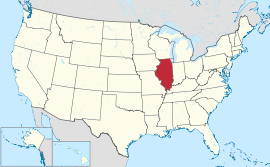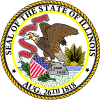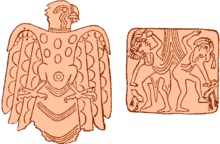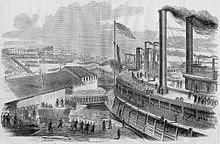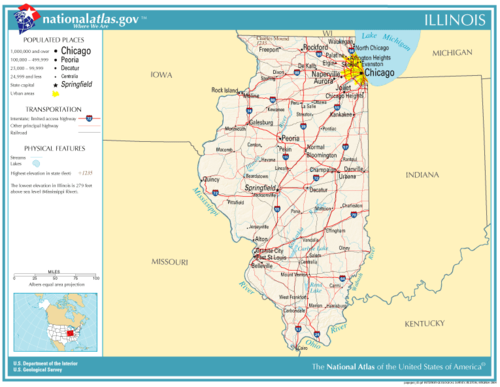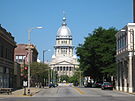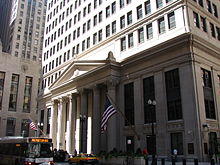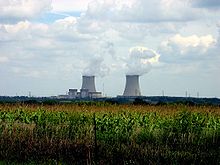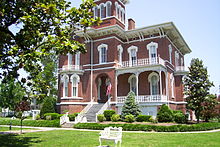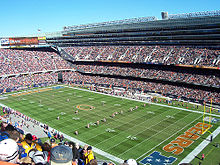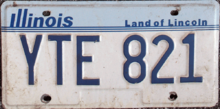- Illinois
-
State of Illinois 

Flag Seal Nickname(s): Land of Lincoln; The Prairie State Motto(s): State sovereignty, national union Official language(s) English[1] Spoken language(s) English (80.8%)
Spanish (10.9%)
Polish (1.6%)
Other (6.7%)[2]Demonym Illinoisan Capital Springfield Largest city Chicago Largest metro area Chicago metropolitan area Area Ranked 25th in the U.S. - Total 57,914 sq mi
(149,998 km2)- Width 210 miles (340 km) - Length 395 miles (629 km) - % water 4.0/ Negligible - Latitude 36° 58′ N to 42° 30′ N - Longitude 87° 30′ W to 91° 31′ W Population Ranked 5th in the U.S. - Total 12,830,632 (2010)[3] - Density 223.4/sq mi (86.27/km2)
Ranked 12th in the U.S.- Median income $54,124[4] (17) Elevation - Highest point Charles Mound[5][6][7]
1,235 ft (376.4 m)- Mean 600 ft (180 m) - Lowest point Confluence of Mississippi River and Ohio River[6][7]
280 ft (85 m)Before statehood Illinois Territory Admission to Union December 3, 1818 (21st) Governor Pat Quinn (D) Lieutenant Governor Sheila Simon (D) Legislature General Assembly - Upper house Senate - Lower house House of Representatives U.S. Senators Dick Durbin (D)
Mark Kirk (R)U.S. House delegation 11 Republicans, 8 Democrats (list) Time zone Central: UTC-6/-5 Abbreviations IL, Ill., US-IL Website illinois.gov Illinois State symbols The Flag of Illinois. The Seal of Illinois. Animate insignia Amphibian Eastern Tiger Salamander Bird(s) Northern Cardinal Butterfly Monarch Butterfly Fish Bluegill Flower(s) Violet Grass Big Bluestem Mammal(s) White-tailed deer Reptile Painted Turtle Tree White oak Inanimate insignia Dance Square dance Food Gold Rush Apple • Popcorn Fossil Tully Monster Mineral Fluorite Poem The Death Poem Slogan(s) "Land of Lincoln" Soil Drummer silty clay loam Song(s) "Illinois" Route marker(s) 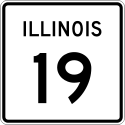
State Quarter 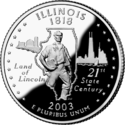
Released in 2003 Lists of United States state insignia Illinois (
 i/ˌɪlɨˈnɔɪ/ il-i-noy) is the fifth-most populous state of the United States of America, and is often noted for being a microcosm of the entire country.[8] With Chicago in the northeast, small industrial cities and great agricultural productivity in central and northern Illinois, and natural resources like coal, timber, and petroleum in the south, Illinois has a broad economic base. Illinois is a major transportation hub. The Port of Chicago connects the state to other global ports from the Great Lakes, via the St. Lawrence Seaway, to the Atlantic Ocean; as well as the Great Lakes to the Mississippi River, via the Illinois River. For decades, O'Hare International Airport has ranked as one of the world's busiest airports. As the "most average state",[8] Illinois has long had a reputation as a bellwether both in social and cultural terms[8] and politics.
i/ˌɪlɨˈnɔɪ/ il-i-noy) is the fifth-most populous state of the United States of America, and is often noted for being a microcosm of the entire country.[8] With Chicago in the northeast, small industrial cities and great agricultural productivity in central and northern Illinois, and natural resources like coal, timber, and petroleum in the south, Illinois has a broad economic base. Illinois is a major transportation hub. The Port of Chicago connects the state to other global ports from the Great Lakes, via the St. Lawrence Seaway, to the Atlantic Ocean; as well as the Great Lakes to the Mississippi River, via the Illinois River. For decades, O'Hare International Airport has ranked as one of the world's busiest airports. As the "most average state",[8] Illinois has long had a reputation as a bellwether both in social and cultural terms[8] and politics.In the 1810s, settlers began arriving from Kentucky. In 1818 Illinois achieved statehood. The state's population originally grew from south to north. Chicago was founded in the 1830s on the banks of the Chicago River, one of the few natural harbors on southern Lake Michigan.[9] Railroads and John Deere's invention of the self-scouring steel plow turned Illinois' rich prairie into some of the world's most productive and valuable farmlands, attracting immigrant farmers from Germany and Sweden. By 1900, the growth of industrial jobs in the northern cities and coal mining in the central and southern areas attracted immigrants from Eastern and Southern Europe. Illinois was an important manufacturing center during both world wars. The Great Migration established a large community of African Americans in Chicago that created the city's famous jazz and blues cultures.[10][11]
Three U.S. Presidents have been elected while living in Illinois — Abraham Lincoln, Ulysses S. Grant, and Barack Obama. Additionally, President Ronald Reagan, whose political career was based in California, was the only US President actually born and raised in Illinois. Today, Illinois honors Lincoln with its official state slogan, Land of Lincoln, which has been displayed on its license plates since 1954.[12][13]
Contents
Name
"Illinois" is the modern spelling for the early French missionaries and explorers' name for the Illinois people, a name that was spelled in many different ways in the early records.[14]
The name "Illinois" has traditionally been said to mean "man" or "men" in the Miami-Illinois language, with the original iliniwek transformed via French into Illinois.[15][16] However, this etymology is not supported by the Illinois language itself, in which the word for 'man' is ireniwa and plural 'men' is ireniwaki. The name Illiniwek has also been said to mean "tribe of superior men",[17] though this is nothing more than a false etymology. In fact the name "Illinois" derives from the Miami-Illinois verb irenwe·wa "he speaks the regular way". This was then taken into the Ojibwe language, perhaps in the Ottawa dialect, and modified into ilinwe· (pluralized as ilinwe·k). These forms were then borrowed into French, where the /we/ ending acquired the spelling -ois. The current form, Illinois, began to appear in the early 1670s. The Illinois's name for themselves, as attested in all three of the French missionary-period dictionaries of Illinois, was Inoka, of unknown meaning and unrelated to the other terms.[18][19][20]
History
Pre-European
Native Americans lived along the waterways of the Illinois area for thousands of years before the arrival of Europeans. The Koster Site has been excavated and demonstrated 7,000 years of continuous habitation. Cahokia, the largest regional chiefdom and urban center of the Pre-Columbian Mississippian culture, was located near present-day Collinsville, Illinois. They built more than 100 mounds and a woodhenge in a planned design expressing the culture's cosmology. The civilization vanished in the 15th century for unknown reasons, but historians and archeologists have speculated that the people depleted the area of resources. Many indigenous tribes engaged in constant warfare. According to Suzanne Austin Alchon, "At one site in the central Illinois River valley, one-third of all adults died as a result of violent injuries."[21]
The next major power in the region was the Illinois Confederation or Illini, a political alliance among several tribes. There were about 25,000 Illinois Indians in 1700, but systematic attacks and warfare by the Iroquois reduced their numbers by 90%.[22] Gradually, members of the Potawatomi, Miami, Sauk, and other tribes came in from the east and north.[23] In the American Revolution, the Illinois and Potawatomi supported the American colonists' cause.
European exploration
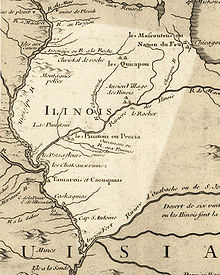 Illinois in 1718, approximate modern state area highlighted, from Carte de la Louisiane et du cours du Mississipi by Guillaume de L'Isle.[24]
Illinois in 1718, approximate modern state area highlighted, from Carte de la Louisiane et du cours du Mississipi by Guillaume de L'Isle.[24]
French explorers Jacques Marquette and Louis Jolliet explored the Illinois River in 1673. In 1680, other French explorers constructed a fort at the site of present day Peoria, and in 1682, a fort atop Starved Rock in today's Starved Rock State Park. As a result of this French exploration, Illinois was part of the French empire until 1763, when it passed to the British with their conquest of New France. The small French settlements continued; a few British soldiers were posted in Illinois, but there were no British or American settlers. In 1778, George Rogers Clark claimed the Illinois Country for Virginia. The area was ceded by Virginia to the new United States in 1783 and became part of the Northwest Territory.[25]
19th century
Historical populations Census Pop. %± 1800 2,458 — 1810 12,282 399.7% 1820 55,211 349.5% 1830 157,445 185.2% 1840 476,183 202.4% 1850 851,470 78.8% 1860 1,711,951 101.1% 1870 2,539,891 48.4% 1880 3,077,871 21.2% 1890 3,826,352 24.3% 1900 4,821,550 26.0% 1910 5,638,591 16.9% 1920 6,485,280 15.0% 1930 7,630,654 17.7% 1940 7,897,241 3.5% 1950 8,712,176 10.3% 1960 10,081,158 15.7% 1970 11,113,976 10.2% 1980 11,426,518 2.8% 1990 11,430,602 0% 2000 12,419,293 8.6% 2010 12,830,632 3.3% Source: 1910–2010[26] The Illinois-Wabash Company was an early claimant to much of Illinois. The Illinois Territory was created on February 3, 1809, with its capital at Kaskaskia.
During the discussions leading up to Illinois' admission to the Union, the proposed northern boundary of the state was moved twice.[27] The original provisions of the Northwest Ordinance had specified a boundary that would have been tangent to the southern tip of Lake Michigan. Such a boundary would have actually left Illinois with no shoreline on Lake Michigan at all. However, as Indiana had successfully been granted a 10-mile northern extension of its boundary to provide it with a usable lakefront, the original bill for Illinois statehood, submitted to Congress on January 23, 1818, stipulated a northern border at the same latitude as Indiana's which is defined as 10 miles (16 km) north of the southernmost extremity of Lake Michigan. But the Illinois delegate, Nathaniel Pope, wanted more. Pope lobbied to have the boundary moved further north, and the final bill passed by Congress did just such; it included an amendment to shift the border to 42° 30' north, which is approximately 51 miles (82 km) north of the Indiana northern border. This shift added 8,500 square miles (22,000 km2) to the state, including the lead mining region near Galena. More importantly, it added nearly 50 miles of Lake Michigan shoreline and the Chicago River. Pope and others envisioned a canal which would connect the Chicago and Illinois rivers, and thusly, connect the Great Lakes to the Mississippi.
In 1818, Illinois became the 21st U.S. state. The capital remained at Kaskaskia, headquartered in a small building rented by the state. In 1819, Vandalia became the capital, and over the next 18 years, three separate buildings were built to serve successively as the capitol building. In 1837, the state legislators representing Sangamon County, under the leadership of state representative Abraham Lincoln, succeeded in having the capital moved to Springfield,[28] where a fifth capitol building was constructed. A sixth capitol building was erected in 1867, which continues to serve as the Illinois capitol today.
Though ostensibly a "free state", Illinois had slavery. The French owned black slaves as late as the 1820s. Slavery was nominally banned by the Northwest Ordnance, but that was not enforced. When Illinois became a sovereign state in 1818, the Ordnance no longer applied, and there were about 900 slaves there. As the southern part of the state, known as "Egypt", was largely settled by migrants from the South, the section was hostile to free blacks and allowed settlers to bring slaves with them for labor. Most citizens were opposed to allowing blacks as permanent residents, and efforts to make slavery official failed in 1822. Nevertheless, some slaves were brought in seasonally or as house servants.[29] The Illinois Constitution of 1848 was written with a provision for exclusionary laws to be passed. In 1853, John A. Logan helped pass a law to prohibit all African Americans, including freedmen, from settling in the state.[30]
In 1832, the Black Hawk War was fought in Illinois and current day Wisconsin between the United States and the Sauk, Fox (Meskwaki) and Kickapoo Indian tribes. The Indians withdrew to Iowa; when they attempted to return, they were defeated by U.S. militia and forced back to Iowa.
The winter of 1830–1831 is called the "Winter of the Deep Snow"; a sudden, deep snowfall blanketed the state, making travel impossible for the rest of the winter, and many travelers perished. Several severe winters followed, including the "Winter of the Sudden Freeze". On December 20, 1836, a fast-moving cold front passed through, freezing puddles in minutes and killing many travelers who could not reach shelter. The adverse weather resulted in crop failures in the northern part of the state. The southern part of the state shipped food north and this may have contributed to its name: "Little Egypt", after the Biblical story of Joseph in Egypt supplying grain to his brothers.[31]
By 1839, the Mormons had founded a utopian city called Nauvoo. Located in Hancock County, along the Mississippi River, Nauvoo flourished and soon rivaled Chicago for the position of the state's largest city. But in 1844, the Mormon leader Joseph Smith was murdered in the Carthage Jail, about 30 miles away from Nauvoo. Soon afterward, after close to six years of rapid development, Nauvoo saw a rapid decline after the Mormons' new leadership led them out of Illinois in a mass exodus to present-day Utah.
Chicago gained prominence as a Great Lakes port and then as an Illinois and Michigan Canal port after 1848, and as a rail hub soon afterward. By 1857, Chicago was Illinois' largest city.[25] With the tremendous growth of mines and factories in the state in the 19th century, Illinois played an important role in the formation of labor unions in the United States. The Pullman Strike and Haymarket Riot in particular greatly influenced the development of the American labor movement. From Sunday, October 8, 1871, until Tuesday, October 10, 1871, the Great Chicago Fire burned in downtown Chicago, destroying 4 square miles (10 km2).[32]
In 1847, after lobbying by Dorothea L. Dix, Illinois became one of the first states to establish a system of state-supported treatment of mental illness and disabilities, replacing local almshouses.
Civil War
.
Main article: Illinois in the Civil WarDuring the American Civil War, over 250,000 Illinois men served in the Union Army, a figure surpassed by only New York, Pennsylvania, and Ohio. Beginning with President Abraham Lincoln's first call for troops and continuing throughout the war, Illinois mustered 150 infantry regiments, which were numbered from the 7th to the 156th regiments. Seventeen cavalry regiments were also gathered, as well as two light artillery regiments.[33] The town of Cairo at the southern tip of the state served as a strategically important supply base and training center for the Union army. For several months, both General Grant and Admiral Foote had headquarters in Cairo.
20th century
At the turn of the 20th century, Illinois had a population of nearly 5 million. Bolstered by continued immigration from southern and eastern Europe, and by African-Americans from Mississippi, Louisiana, and Arkansas, Illinois grew and emerged as one of the most important states in the union. By the end of the century, the population had reached 12.4 million.
The Century of Progress World's Fair was held at Chicago in 1933. Oil strikes in Marion County and Crawford County lead to a boom in 1937, and, by 1939, Illinois ranked fourth in U.S. oil production. Chicago became an ocean port with the opening of the Saint Lawrence Seaway in 1959. The seaway and the Illinois Waterway connected Chicago to both the Mississippi River and the Atlantic Ocean. In 1960, Ray Kroc opened the first McDonald's franchise in Des Plaines (which still exists today as a museum, with a working McDonald's across the street).
No state has had a more prominent role than Illinois in the emergence of the nuclear age. As part of the Manhattan Project, the first sustained nuclear chain reaction took place at the University of Chicago in 1942. In 1957, Argonne National Laboratory, near Chicago, activated the first experimental nuclear power generating system in the United States. By 1960, the first privately financed nuclear plant in United States, Dresden 1, was dedicated near Morris. In 1967, Fermilab, a national nuclear research facility near Batavia, opened a particle accelerator which was the world's largest for over 40 years. And, with eleven plants currently operating, Illinois leads all states in the amount of electricity generated from nuclear power.[34]
The state's fourth constitution was adopted in 1970, replacing the 1870 document. The first Farm Aid concert was held in Champaign to benefit American farmers, in 1985. The worst upper Mississippi River flood of the century, the Great Flood of 1993, inundated many towns and thousands of acres of farmland.[25]
Geography
Boundaries
Illinois' eastern border with Indiana consists of a north-south line at 87° 31′ 30″ west longitude, from Lake Michigan to the Wabash River, above Post Vincennes. The Wabash River continues as the eastern/southeastern border with Indiana, until the Wabash enters the Ohio River. This marks the beginning of Illinois' southern border with Kentucky, which runs along the northern shoreline of the Ohio River.[35] Its western border with Missouri and Iowa is the Mississippi River. Its northern border with Wisconsin is fixed at 42° 30' north latitude. The northeastern border of Illinois actually lies within Lake Michigan, within which Illinois shares a water boundary with the state of Michigan.[23]
Topography
Though Illinois lies entirely in the Interior Plains, it does have some minor variation in its elevation. In extreme northwestern Illinois, the Driftless Area, a region of unglaciated and therefore higher and more rugged topography, occupies a small part of the state. Charles Mound, located in this region, has the state's highest elevation above sea level at 1,235 feet (376 m). The floodplain on the Mississippi River from Alton to the Kaskaskia River is known as the American Bottom.
Divisions
Illinois has three major geographical divisions. Northern Illinois is dominated by the Chicago metropolitan area; the city of Chicago, its suburbs, and the adjoining exurban area into which the metropolis is expanding. As defined by the federal government, the Chicago metro area includes several counties in Illinois, Indiana, and Wisconsin. Chicago is a cosmopolitan city, densely populated, industrialized, the transportation hub of the nation, and settled by a wide variety of ethnic groups with a population of 9.8 million people. The city of Rockford, the fourth largest metropolitan area, and the state's third largest city, sits along Interstates 39 and 90 some 75 miles (121 km) northwest of Chicago. The Quad Cities region, located along the Mississippi River in northern Illinois, had a population of 379,066 in 2009.
Southward and westward, the second major division is Central Illinois, an area of mostly prairie. Known as the Heart of Illinois, it is characterized by small towns and mid-sized cities. The western section (west of the Illinois River) was originally part of the Military Tract of 1812 and forms the conspicuous western bulge of the state. Agriculture, particularly corn and soybeans, as well as educational institutions and manufacturing centers, figure prominently. Cities include Peoria, the third largest metropolitan area in Illinois at 370,000; Springfield, the state capital; Quincy; Decatur; Bloomington-Normal; and Champaign-Urbana.[23]
The third division is Southern Illinois, comprising the area south of U.S. Route 50, including Little Egypt, near the juncture of the Mississippi River and Ohio River. Southern Illinois is the site of the ancient city of Cahokia, as well as the site of the first state capital at Kaskaskia, which today is separated from the rest of the state by the Mississippi River.[23][36] This region can be distinguished from the other two by its warmer climate, different variety of crops (including some cotton farming in the past), more rugged topography (due to the area remaining unglaciated during the Illinoian Stage, unlike most of the rest of the state), as well as small-scale oil deposits and coal mining. The Illinois suburbs of St. Louis comprise the second most populous metropolitan area in Illinois with over 700,000 inhabitants, and are known collectively as the Metro-East. The other significant concentration of population in Southern Illinois is the Carbondale-Marion-Herrin, Illinois Combined Statistical Area centered on Carbondale and Marion, a two-county area that is home to 123,272 residents.[23] A portion of southeastern Illinois is part of the extended Evansville, Indiana Metro Area, locally referred to as the Tri-State with Indiana and Kentucky. Seven Illinois counties are in the area.
In addition to these three, largely latitudinally defined divisions, all of the region outside of the Chicago Metropolitan area is often called "downstate" Illinois. This term is flexible, but is generally meant to mean everything outside the Chicago-area. Thus, some cities in Northern Illinois, such as DeKalb, which is west of Chicago, and Rockford—which is actually north of Chicago—are considered to be "downstate".
Climate
Because of its nearly 400 mile distance from its northernmost and southernmost extremes, as well as its mid-continental situation, Illinois has a widely varying climate. Most of Illinois has a humid continental climate (Köppen climate classification Dfa), with hot, humid summers and cold winters. The southernmost part of the state, from about Carbondale southward, borders on a humid subtropical climate (Koppen Cfa), with more moderate winters. Average yearly precipitation for Illinois varies from just over 48 inches (1,219 mm) at the southern tip to around 35 inches (889 mm) in the northern portion of the state. Normal annual snowfall exceeds 38 inches (965 mm) in the Chicago area, while the southern portion of the state normally receives less than 14 inches (356 mm).[37] The all time high temperature was 117 °F (47 °C), recorded on July 14, 1954, at East St. Louis, Illinois, while the all time low temperature was −36 °F (−38 °C), recorded on January 5, 1999, at Congerville, Illinois.[38]
Illinois averages around 51 days of thunderstorm activity a year, which ranks somewhat above average in the number of thunderstorm days for the United States. Illinois is vulnerable to tornadoes with an average of 35 occurring annually, which puts much of the state at around five tornadoes per 10,000 square miles (30,000 km2) annually.[39] The deadliest tornadoes on record in the nation have occurred largely in Illinois, not because the tornadoes are more common or frequent in Illinois, but rather, because Illinois is simply the most populous state in Tornado Alley. The Tri-State Tornado of 1925 killed 695 people in three states; 613 of the victims died in Illinois.[40] Modern developments in storm tracking have caused death tolls from tornadoes to dramatically decline since the 1960s, with no major losses of life in the state since the 1967 tornado storm in northern Illinois.
City Jan Feb Mar Apr May Jun Jul Aug Sep Oct Nov Dec Cairo[41] 41/25 47/29 57/39 69/50 77/58 86/67 90/71 88/69 81/61 71/49 57/39 46/30 Chicago[42] 30/16 36/21 47/30 59/40 71/51 81/61 85/65 83/65 75/57 64/45 48/34 36/22 Edwardsville[43] 36/19 42/24 52/34 64/45 75/55 84/64 89/69 86/66 79/58 68/46 53/35 41/25 Moline[44] 30/12 36/18 48/29 62/39 73/50 83/60 86/64 84/62 76/53 64/42 48/30 34/18 Peoria[45] 31/14 37/20 49/30 62/40 73/51 82/60 86/65 84/63 77/54 64/42 49/31 36/20 Rockford[46] 27/11 33/16 46/27 59/37 71/48 80/58 83/63 81/61 74/52 62/40 46/29 32/17 Springfield[47] 33/17 39/22 51/32 63/42 74/53 83/62 86/66 84/64 78/55 67/44 51/34 38/23 Demographics
In the 2010 Census, Illinois was found to have a population of 12,830,632, representing a slightly lower increase than had been anticipated in estimates from two years earlier. Illinois is the most populous state in the Midwest region. Chicago, the third most populous city in the United States, is the center of the Chicago metropolitan area. Chicagoland, as this area is known locally, comprises only 8% of the land area of the state, but contains 65% of the state's residents.
Specific demographic data from the 2010 Census is not subject to release until March 2011, but as of the 2007 estimates from the U.S. Census Bureau, there were 1,768,518 foreign-born inhabitants of the state or 13.8% of the population, with 48.4% from Latin America, 24.6% from Asia, 22.8% from Europe, 2.9% from Africa, 1.2% from Northern America and 0.2% from Oceania. Of the foreign-born population, 43.7% were naturalized U.S. citizens and 56.3% were not U.S. citizens.[48] Additionally, the racial distributions were as follows: 65.0% White American, 15.0% African American, 14.9% Latino American, 4.3% Asian American, 0.3% American Indian and Alaska Natives, and 0.1% Native Hawaiians and Pacific Islander American.[49] In 2007, 6.9% of Illinois' population was reported as being under age 5, 24.9% under age 18 and 12.1% were age 65 and over. Females made up approximately 50.7% of the population.[49]
According to the 2007 estimates, 21.1% of the population had German ancestry, 13.3% had Irish ancestry, 7.9% had Polish ancestry, 6.7% had English ancestry, 6.4% had Italian ancestry, 4.6% listed themselves as American, 2.4% had Swedish ancestry, 2.2% had French ancestry, other than Basque, 1.6% had Dutch ancestry, 1.4% had Norwegian ancestry and 1.3% had Scottish ancestry.[48] Also, 21.8% of the population age 5 years and over reported speaking a language other than English, with 12.8% of the population speaking Spanish, 5.6% speaking other Indo-European languages, 2.5% speaking Asian and Austronesian languages, and 0.8% speaking other languages.[48]
Chicago, along the shores of Lake Michigan, is the nation's third largest city. In 2000, 23.3% of Illinois' population lived in the city of Chicago, 43.3% in Cook County and 65.6% in the counties of the Chicago metropolitan area: Will, DuPage, Kane, Lake and McHenry counties, as well as Cook County. The remaining population lives in the smaller cities and rural areas that dot the state's plains. As of 2000, the state's center of population was at 41°16′42″N 88°22′49″W / 41.278216°N 88.380238°W, located in Grundy County, northeast of the village of Mazon.[23][25][36][50]
Largest cities Rank City Population[51] County

Chicago
Springfield
(State Capital)1 Chicago 2,695,598 Cook, DuPage 2 Aurora 197,899 DuPage Kane Kendall Will 3 Rockford 152,871 Winnebago 4 Joliet 147,433 Will 5 Naperville 141,853 DuPage, Will 6 Springfield 117,352 Sangamon 7 Peoria 115,007 Peoria 8 Elgin 108,188 Cook, Kane based on 2010 U.S. Census Urban areas
Chicago is the largest city in the state and the third most populous city in the United States, with its 2010 population of 2,695,598. The U.S. Census Bureau currently lists seven other cities with populations of over 100,000 within Illinois. Based upon the Census Bureau's official 2010 population,[52]: Aurora, a Chicago satellite town which eclipsed Rockford for the title of "Second City" of Illinois in 2006; its 2010 population was 197,899. Rockford, at 152,871, is the third largest city in the state, and is also the largest city in the state not located within the Chicago metropolitan area. Joliet, located southwest of Chicago, is the fourth largest city in the state, with a population of 147,433. Naperville, a suburb of Chicago, is fifth with 141,853; Naperville and Aurora (the 2nd largest city) share a boundary along Illinois Route 59. Springfield, the state capital of Illinois, comes in sixth with 117,352. Peoria, which decades ago was the second largest city in the state, comes in seventh with 115,007. The eighth largest and final city in the 100,000 club is Elgin, a northwest suburb of Chicago with a 2010 population of 108,188.
The most populated city in the state south of Springfield is Belleville, with 44,478 people at the 2010 census. It is located in the Illinois portion of Greater St. Louis (often called the Metro-East area), which has a rapidly growing population of over 700,000 people.
Other major urban areas include the Champaign-Urbana Metropolitan Area, which has a combined population of almost 230,000 people, the Illinois portion of the Quad Cities area with about 215,000 people, and the Bloomington-Normal area with a combined population of over 165,000.
Religion
Religious affiliation No religion: 15%Christian: 7%Lutheran: 7%Methodist: 6%Not specified: 4%Other: 3%Presbyterian: 3%Non-denominational: 2%Pentecostal: 2%Protestant: 2%Buddhist: 1%Jewish: 1%Muslim/Islamic: 1%(2001 estimate)[53] Roman Catholics constitute the single largest religious denomination in Illinois; they are heavily concentrated in and around Chicago, and account for nearly 30% of the state's population.[54] However, taken together as a group, the various Protestant denominations comprise a greater percentage of the state's population than do Catholics. In 2000 Catholics in Illinois numbered 3,874,933, the largest Protestant denominations were the United Methodist Church, with 365,182 members, and the Southern Baptist Convention, with 305,838. Jews constituted the largest non-Christian group with 270,000 adherents.[55] Chicago and its suburbs are also home to a large and growing population of Hindus, Muslims, Baha'is and Sikhs.
Illinois played an important role in the early Latter Day Saint movement, with Nauvoo, Illinois, becoming a gathering place for Mormons in the early 1840s. Nauvoo was the location of the succession crisis, which led to the separation of the Mormon movement into several Latter Day Saint sects. The Church of Jesus Christ of Latter-day Saints, the largest of the sects to emerge from the Mormon schism, claims 55,460 in Illinois today.[56]
Demographics of Illinois (csv) By race White Black AIAN* Asian NHPI* 2000 (total population) 80.71% 15.73% 0.62% 3.84% 0.11% 2000 (Hispanic only) 11.78% 0.35% 0.19% 0.08% 0.04% 2005 (total population) 80.34% 15.63% 0.62% 4.45% 0.11% 2005 (Hispanic only) 13.72% 0.39% 0.20% 0.09% 0.04% Growth 2000–05 (total population) 2.30% 2.07% 3.74% 19.16% 10.13% Growth 2000–05 (non-Hispanic only) -0.68% 1.81% 0.91% 19.36% 10.18% Growth 2000–05 (Hispanic only) 19.75% 13.28% 10.14% 9.96% 10.06% * AIAN is American Indian or Alaskan Native; NHPI is Native Hawaiian or Pacific Islander Economy
The dollar gross state product for Illinois was estimated to be US$652 billion in 2010.[57] The state's 2010 per capita gross state product was estimated to be US$45,302,[57] and the state's per capita personal income was estimated to be US$41,411 in 2009.[58]
As of March 2010[update], the state's unemployment rate was 11.5%,[59] which fell to 9.9% by August 2011.[60]
Taxes
Illinois' state income tax is calculated by multiplying net income by a flat rate. In 1990, that rate was set at 3%, but in 2010, the General Assembly voted in a temporary increase in the rate to 5%; the new rate went into effect on January 1, 2011, and is scheduled to return to 3% after four years.[61][62] There are two rates for state sales tax: 6.25% for general merchandise and 1% for qualifying food, drugs and medical appliances.[63] The property tax is the largest single tax in Illinois, and is the major source of tax revenue for local government taxing districts. The property tax is a local — not state — tax, imposed by local government taxing districts, which include counties, townships, municipalities, school districts and special taxation districts. The property tax in Illinois is imposed only on real property.[23][25][36]
Agriculture
Illinois' major agricultural outputs are corn, soybeans, hogs, cattle, dairy products, and wheat. In most years, Illinois is either the first or second state for the highest production of soybeans, with a harvest of 427.7 million bushels (11.64 million metric tons) in 2008, after Iowa's production of 444.82 million bushels (12.11 million metric tons).[64] Illinois ranks second in U.S. corn production with more than 1.5 billion bushels produced annually.[65] Illinois also produces wine, and the state is home to two American viticultural areas. Illinois' universities are actively researching alternative agricultural products as alternative crops.
Manufacturing
Illinois is one of the nation's manufacturing leaders, boasting annual value added productivity by manufacturing of over $107 billion in 2006. About three-quarters of the state's manufacturers are located in the Northeastern Opportunity Return Region, with 38 percent of Illinois' approximately 18,900 manufacturing plants located in Cook County. As of 2006, the leading manufacturing industries in Illinois, based upon value-added, were chemical manufacturing ($18.3 billion), machinery manufacturing ($13.4 billion), food manufacturing ($12.9 billion), fabricated metal products ($11.5 billion), transportation equipment ($7.4 billion), plastics and rubber products ($7.0 billion), and computer and electronic products ($6.1 billion).[66]
Services
By the early 2000s, Illinois' economy had moved toward a dependence on high-value-added services, such as financial trading, higher education, law, logistics, and medicine. In some cases, these services clustered around institutions that hearkened back to Illinois' earlier economies. For example, the Chicago Mercantile Exchange, a trading exchange for global derivatives, had begun its life as an agricultural futures market. Other important non-manufacturing industries include publishing, tourism, and energy production and distribution.
Energy
Illinois is a net importer of fuels for energy, despite large coal resources and some minor oil production. Illinois exports electricity, ranking fifth among states in electricity production and seventh in electricity consumption.[67]
Coal
The coal industry of Illinois has its origins in the middle 19th century, when entrepreneurs such as Jacob Loose discovered coal in locations such as Sangamon County. Jacob Bunn contributed to the development of the Illinois coal industry, and was a founder and owner of the Western Coal & Mining Company of Illinois. About 68% of Illinois has coal-bearing strata of the Pennsylvanian geologic period. According to the Illinois State Geological Survey, 211 billion tons of bituminous coal are estimated to lie under the surface, having a total heating value greater than the estimated oil deposits in the Arabian Peninsula.[68] However, this coal has a high sulfur content, which causes acid rain unless special equipment is used to reduce sulfur dioxide emissions.[23][25][36] Many Illinois power plants are not equipped to burn high-sulfur coal. In 1999, Illinois produced 40.4 million tons of coal, but only 17 million tons (42%) of Illinois coal was consumed in Illinois. Most of the coal produced in Illinois is exported to other states, while much of the coal burned for power in Illinois (21 million tons in 1998) is mined in the Powder River Basin of Wyoming.[67]
Mattoon was recently chosen as the site for the Department of Energy's FutureGen project, a 275 megawatt experimental zero emission coal-burning power plant which just received a second round of funding from the DOE.
Petroleum
Illinois is a leading refiner of petroleum in the American Midwest, with a combined crude oil distillation capacity of nearly 900,000 barrels per day (140,000 m3/d). However, Illinois has very limited crude oil proved reserves that account for less than 1% of U.S. crude oil proved reserves. Residential heating is 81% natural gas compared to less than 1% heating oil. Illinois is ranked 14th in oil production among states, with a daily output of approximately 28,000 barrels (4,500 m3) in 2005.[69]
Nuclear power
Nuclear power arguably began in Illinois with the Chicago Pile-1, the world's first artificial self-sustaining nuclear chain reaction in the world's first nuclear reactor, built on the University of Chicago campus. There are six operating nuclear power plants in Illinois: Braidwood; Byron; Clinton; Dresden; LaSalle; and Quad Cities. With the exception of the single-unit Clinton plant, each of these facilities has two reactors. Three reactors have been permanently shut down and are in various stages of decommissioning: Dresden-1 and Zion-1 and 2. As of 2008[update], Illinois was ranked first among the 50 states both in nuclear capacity and nuclear generation.[70] In 2007, 48% of Illinois' electricity was generated using nuclear power.[70]
Wind power
Illinois has seen growing interest in the use of wind power for electrical generation.[71] Most of Illinois was rated in 2009 as "marginal or fair" for wind energy production by the U.S. Department of Energy, with some western sections rated "good" and parts of the south rated "poor".[72] These ratings are for wind turbines with 50-metre (160 ft) hub heights; newer wind turbines are taller, enabling them to reach stronger winds farther from the ground. As a result, more areas of Illinois have become prospective wind farm sites. As of September 2009, Illinois had 1116.06 MW of installed wind power nameplate capacity with another 741.9 MW under construction.[73] Illinois ranked ninth among U.S. states in installed wind power capacity, and sixteenth by potential capacity.[73] Large wind farms in Illinois include Twin Groves, Rail Splitter, EcoGrove, and Mendota Hills.[73]
As of 2007, wind energy represented only 1.7% of Illinois' energy production, and it was estimated that wind power could provide 5–10% of the state's energy needs.[74][75] Also, the Illinois General Assembly mandated in 2007 that by 2025, 25% of all electricity generated in Illinois is to come from renewable resources.[76]
Biofuels
Illinois is ranked second in corn production among U.S. states, and Illinois corn is used to produce 40% of the ethanol consumed in the United States.[65] The Archer Daniels Midland corporation in Decatur, Illinois is the world's leading producer of ethanol from corn.
University of Illinois at Urbana-Champaign is one of the partners in the Energy Biosciences Institute (EBI), a $500 million biofuels research project funded by petroleum giant BP.[77][78]
Arts and culture
Museums
Illinois has numerous museums; the greatest concentration of these is in Chicago. Numerous museums in the city of Chicago are considered some of the best in the world. These include the John G. Shedd Aquarium, the Field Museum of Natural History, the Art Institute of Chicago, the Adler Planetarium, and the Museum of Science and Industry.
The state of the art Abraham Lincoln Presidential Library and Museum in Springfield is the largest presidential library in the country. Other historical museums in the state include Magnolia Manor in Cairo, the Elihu Benjamin Washburne and Ulysses S. Grant Homes, both in Galena, and the Polish Museum of America in Chicago.
Music
Illinois is a leader in music education having hosted the Midwest Clinic: An International Band and Orchestra Conference since 1946, as well being home to the Illinois Music Educators Association (IMEA), one of the largest professional music educator's organizations in the country. Each summer since 2004, Southern Illinois University Carbondale has played host to the Southern Illinois Music Festival, which presents dozens of performances throughout the region. Past featured artists include the Eroica Trio and violinist David Kim.
Sports
Major league teams
As one of the United States' major metropolises, all major sports leagues have teams headquartered in Chicago.
- Two Major League Baseball teams are located in the state. The Chicago Cubs of the National League play in the second-oldest major league stadium (Wrigley Field) and are widely known for having the longest championship drought in all of major American sport: not winning the World Series since 1908.[79][80] The Chicago White Sox of the American League won the World Series in 2005, their first since 1917.
- The Chicago Bears football team has won nine total NFL Championships, the last occurring in Super Bowl XX in 1986.
- The Chicago Bulls of the NBA is one of the most recognized basketball teams in the world, due largely to the efforts of Michael Jordan, who led the team to six NBA championships in eight seasons in the 1990s.
- The Chicago Blackhawks of the NHL began playing in 1926, as a member of the Original Six and have won four Stanley Cups, most recently in 2010.
- The Chicago Fire soccer club is a member of MLS and is one of the league's most successful and best-supported, since its founding in 1997, winning one league and four Lamar Hunt U.S. Open Cups in that timespan.
Minor league teams
Many minor league teams also call Chicago their home. These include
- The Chicago Rush of the Arena Football League, who won ArenaBowl XX in 2006.
- The Chicago Wolves is an AHL team.
- The Chicago Sky of the WNBA
- The Chicago Bandits of the NPF, a female softball league; the Bandits won their first title in 2008
- The Chicago Red Stars of the WPS, a female soccer league
Former Chicago sports franchises
Folded teams
The city was formerly home to several other teams that either failed to survive, or that belonged to leagues that folded.
- The Chicago Blitz, United States Football League
- The Chicago Sting, Major Indoor Soccer League
- The Chicago Cougars, World Hockey Association
- The Chicago Rockers, Continental Basketball Association
- The Chicago Skyliners, American Basketball Association
- The Chicago Bruisers, Arena Football League
- The Chicago Power, National Professional Soccer League
- The Chicago Blaze, National Women's Basketball League.
Relocated teams
The NFL's Arizona Cardinals, who currently play in Phoenix, Arizona, played in Chicago as the Chicago Cardinals, until moving to St. Louis, Missouri after the 1959 season.
Professional sports teams outside of Chicago
Chicago is not the only place in Illinois where professional sports are played. The Rockford Lightning is one of the oldest CBA teams in the league. The Peoria Chiefs and Kane County Cougars are minor league baseball teams affiliated with MLB. The Schaumburg Flyers and Lake County Fielders are members of the North American League, and the Southern Illinois Miners, Gateway Grizzlies, Joliet Slammers, Windy City ThunderBolts and Normal CornBelters belong to the Frontier League.
In addition to the Chicago Wolves, the AHL also has two teams in Illinois outside of Chicago: the Rockford IceHogs serves as the AHL affiliate of the Chicago Blackhawks, and the Peoria Rivermen is the AHL affiliate of the St. Louis Blues.
Motor racing
Illinois has a long tradition of motor racing. Oval tracks at the Chicagoland Speedway in Joliet, the Chicago Motor Speedway in Cicero and the Gateway International Raceway in Madison, near St. Louis, have hosted NASCAR, CART and IRL races, whereas the Sports Car Club of America, among other national and regional road racing clubs, have visited the Autobahn Country Club in Joliet, the Blackhawk Farms Raceway in South Beloit and the former Meadowdale International Raceway in Carpentersville. Illinois also has several short tracks and dragstrips. The dragstrip at Gateway International Raceway and the Route 66 Raceway, which sits on the same property as the Chicagoland Speedway, both host NHRA drag races.
Parks and recreation
The Illinois state parks' system began in 1908 with what is now Fort Massac State Park, becoming the first park in a system encompassing over 60 parks and about the same number of recreational and wildlife areas.
Areas under the protection and control of the National Park Service include: the Illinois and Michigan Canal National Heritage Corridor near Lockport;[81] the Lewis and Clark National Historic Trail; the Lincoln Home National Historic Site in Springfield; the Mormon Pioneer National Historic Trail; the Trail of Tears National Historic Trail; and the American Discovery Trail.[82]
In March 2011, Illinois ranked as a bottom-seven "Worst" state (tied with Georgia and Oklahoma) in the American State Litter Scorecard. The Land of Lincoln suffers from overall poor effectiveness and quality of its statewide public space cleanliness—due to state and related eradication standards and performance indicators.[83]
Governance
While the organization of the central government of Illinois is largely the same as every other state (having three branches of government: executive, legislative and judicial), below this top level, the substructure of Illinois' government is extremely complex, arguably the most complex of all fifty states.
State government structure
Legislative functions are granted to the Illinois General Assembly, composed of the 118-member Illinois House of Representatives and the 59-member Illinois Senate. The executive branch is led by the Governor of Illinois, but four other executive officials are separately elected by the people. The judiciary is composed of the Supreme Court of Illinois and the lower appellate and circuit courts.[35]
Illinois' uniquely complex local government structure
Illinois has more units of local government than any other state—over 8,000 in all.[84] The basic subdivision of Illinois is like almost every other state, the county, and Illinois has 102 of these. About half of these counties, in turn, are divided into townships, which is much the same as many other Midwestern states. And finally, Illinois has a number of cities, villages, and towns commensurate with a state of its size. But the counties, townships, and municipal governments in Illinois make up only about 1/4 of all of the governmental units in the state. The reason Illinois has so many units of government is because so many single-purpose governmental entities have been created. The following is just a partial list of the types of single-purpose governmental units in Illinois.
- Illinois has school districts which do not share boundaries with either counties nor townships. While this is not unique to Illinois, what would strike observers from many other states as odd, is that there are many places where a given piece of land sits within two school districts—one high school district, and another elementary district—each of which has its own school board and its own taxing authority.
- Another common political unit is the library district.[85] Library districts are run by library boards; such boards are elected bodies and have the power to levy taxes in their district.[86] Library boards in some districts are elected at the general election, but in other districts may be held in conjunction with local elections, or even, as stand-alone elections.[87] The boundaries of these library districts occasionally coincide with those of another governmental entity, such as a township, but more often, they are set independently.
- Another unit of government with taxation authority is the sanitary district,[88] a euphemism for "sewage district". (Many Illinoisians first learned of the existence of these entities when, in 1978, a sanitary district board member named Alex Seith captured the Democratic nomination for U.S. Senate against the veteran senator Charles Percy and nearly upset him in the general election.) The largest of the sanitary districts in the state is the Metropolitan Water Reclamation District of Greater Chicago (né Sanitary District of Chicago), which oversaw the reversal of the course of the Chicago River.
There are additional units of government that oversee watersheds, land use, and many other functions that in another state would be handled by the county or city governments.
Homerule
The Constitution of 1970 created, for the first time in Illinois, a type of "home rule", which allows cities of certain sizes to opt out of certain types of state laws.
Law enforcement
The complexity and overlapping jurisdictions of Illinois' law enforcement agencies is not unlike that of the overlapping taxing authorities noted above. At the state level, there are at least eleven law enforcement agencies. At the county level, there are sheriffs, forest preserve police and other specialized police forces. At the local level, most cities and many villages have municipal police forces, park district police forces, and even local specialized police forces. Many colleges also have their own campus police that are often sworn police officers.
In 2000, Illinois was ranked 4th in the U.S. in the number of full-time sworn officers with 321 per 100,000 persons, behind Louisiana (415), New York (384), and New Jersey (345).[89] In this ranking, only New York had a higher total population than Illinois. Illinois is also near the top of most law enforcement numbers lists, such as number of agencies per state, number of agencies with special jurisdictions, and number of local police agencies.[89] Even taking into account that Illinois is the fifth most populous state, many of the ratios are higher than more populated states. There is much overlap in jurisdiction amongst the different law enforcement agencies.
Politics
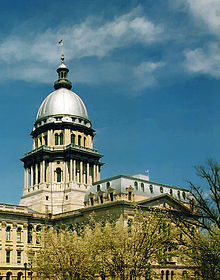 The dome on the Illinois State Capitol in Springfield is taller than the dome on the United States Capitol.
The dome on the Illinois State Capitol in Springfield is taller than the dome on the United States Capitol.
Party balance
Historically, Illinois was long a major swing state, with near-parity existing between the Republican and the Democratic parties. However, in recent elections, the Democratic Party has slowly gained ground, and Illinois has come to be seen as more of a "blue" state.[90][91] Chicago and most of Cook County votes have long been strongly Democratic. In addition, Democratic voters have moved to the traditionally Republican "collar counties" (the suburbs surrounding Chicago's Cook County, Illinois), which are becoming increasingly diverse.[92][93]
Republicans continue to prevail in rural northern and central Illinois; Republican support is strong in southern Illinois outside of the East St. Louis metropolitan area. Illinois has voted for Democratic presidential candidates in the last five elections. State resident Barack Obama easily won the state's 21 electoral votes in 2008, by a margin of 25 percentage points with 61.9% of the vote. And though the Republicans' electoral performance in the 2010 mid-year elections marked some improvement, the trend in Illinois politics for the long term appears to be more blue than red.[94][95]
History of corruption
Politics in the state, particularly those of the Chicago machine, have been famous for highly visible corruption cases, as well as for crusading reformers, such as governors Adlai Stevenson (D) and James R. Thompson (R). In 2006, former Governor George Ryan (R) was convicted of racketeering and bribery. In 2008, then-Governor Rod Blagojevich (D) was served with a criminal complaint on corruption charges, stemming from allegations that he conspired to sell the vacated Senate seat left by President Barack Obama (D) to the highest bidder. In the late 20th century, Congressman Dan Rostenkowski (D) was imprisoned for mail fraud; former governor and federal judge Otto Kerner, Jr. (D) was imprisoned for bribery; and State Auditor of Public Accounts (Comptroller) Orville Hodge (R) was imprisoned for embezzlement. In 1912, William Lorimer, the GOP boss of Chicago, was expelled from the U.S. Senate for bribery and in 1921, Governor Len Small (R) was found to have defrauded the state of a million dollars.[25][36][96]
US Presidents from Illinois
Three presidents have claimed Illinois as their political base: Lincoln, Grant, and Obama. Lincoln was born in Kentucky, but moved to Illinois at the age of 21; he served in the General Assembly and represented the 7th congressional district in the US House of Representatives before his election as President. Ulysses S. Grant was born in Ohio and had a military career that precluded settling down, but on the eve of the Civil War, and approaching middle age, Grant moved to Illinois and thus claimed it as his home when running for President. Barack Obama was born and raised in Hawaii (other than a four year period of his childhood spent in Indonesia) and made Illinois his home and base after completing law school.
Only one person elected President of the United States was actually born in Illinois. Ronald Reagan was born in Tampico, raised in Dixon and educated at Eureka College. Reagan moved to Los Angeles as a young adult and later became Governor of California before being elected President.
Though never elected president, Illinois Governor Adlai Stevenson, who was born and raised in central Illinois, was the Democratic nominee for president in 1952 and 1956.
Black senators
Since the adoption of the United States Constitution in 1789, only six African-Americans have served as members of the United States Senate, and half of them represented Illinois: Carol Moseley-Braun, Barack Obama,[97] and Roland Burris, who was appointed to replace Obama after his election to the presidency.
Education
Illinois State Board of Education
The Illinois State Board of Education (ISBE) is autonomous of the governor and the state legislature, and administers public education in the state. Local municipalities and their respective school districts operate individual public schools but the ISBE audits performance of public schools with the Illinois School Report Card. The ISBE also makes recommendations to state leaders concerning education spending and policies.
Primary and secondary schools
Education is compulsory from ages 7 to 17 in Illinois. Schools are commonly but not exclusively divided into three tiers of primary and secondary education: elementary school, middle school or junior high school and high school. District territories are often complex in structure. Many areas in the state are actually located in two school districts—one for high school, the other for elementary and middle schools. And such districts do not necessarily share boundaries. A given high school may have several elementary districts that feed into it, yet some of those feeder districts may themselves feed into multiple high school districts.
Colleges and universities
Using the criterion established by the Carnegie Foundation for the Advancement of Teaching, there are eleven "National Universities" in the state. As of 19 August 2010[update], five of these rank in the "first tier" (that is, the top quartile) among the top 500 National Universities in the United States, as determined by the U.S. News & World Report rankings: the University of Chicago (8), Northwestern University (12), the University of Illinois at Urbana-Champaign (39), Illinois Institute of Technology (106), and Loyola University Chicago (119).[98]
Illinois also has more than 20 additional accredited four-year universities, both public and private, and dozens of small liberal arts colleges across the state. Additionally, Illinois supports 49 public community colleges in the Illinois Community College System.
Infrastructure
Transportation
See also: List of airports in Illinois, List of Illinois Routes, List of Illinois railroads, and Category:Illinois waterwaysBecause of its central location and its proximity to the Rust Belt and Grain Belt, Illinois is a national crossroads for air, auto, rail and truck traffic.
Airports
From 1962 until 1998, Chicago's O'Hare International Airport (ORD) was the busiest airport in the world, measured both in terms of total flights and passengers. While it was surpassed by Atlanta's Hartsfield in 1998, with 59.3 million domestic passengers annually, along with 11.4 million international passengers in 2008,[99] O'Hare remains one of the two or three busiest airports in the world, and some years still ranks number one in total flights. It is a major hub for United Airlines and American Airlines, and a major airport expansion project is currently underway. Chicago Midway International Airport (MDW), which had been the busiest airport in the world until supplanted by O'Hare in 1962, is now the secondary airport in the Chicago metropolitan area. For a time in the late 1960s and 1970s, Midway was nearly vacant except for general aviation, but growth in the area, combined with political deadlock over the building of a new major airport in the region, has caused a resurgence for Midway. It is now a major hub for Southwest Airlines, and services many other airlines as well. Midway served 17.3 million domestic and international passengers in 2008.[100]
Rail
Illinois has an extensive passenger and freight rail transportation network. Chicago is a national Amtrak hub and in-state passengers are served by Amtrak's Illinois Service, featuring the Chicago to Carbondale Illini and Saluki, the Chicago to Quincy Carl Sandburg and Illinois Zephyr, and the Chicago to St. Louis Lincoln Service. Currently there is trackwork on the Chicago-St. Louis line to bring the maximum speed up to 110 mph (180 km/h) which would reduce the trip time by an hour and a half. Nearly every North American railway meets at Chicago, making it the largest and most active rail hub in the country. Extensive commuter rail is provided in the city proper and some immediate suburbs by the Chicago Transit Authority's 'L' system. The largest suburban commuter rail system in the United States, operated by Metra, uses existing rail lines to provide direct commuter rail access for hundreds of suburbs to the city and beyond.
In addition to the state's rail lines, the Mississippi River and Illinois River provide major transportation routes for the state's agricultural interests. Lake Michigan gives Illinois access to the Atlantic Ocean by way of the Saint Lawrence Seaway.
Interstate highway system
Illinois' central location and large population are the reasons that Illinois carries the distinction of having the most primary (2-digit) Interstates pass through it among the 50 states.
Major U.S. Interstate highways crossing the state include: I-24, I-39, I-55, I-57, I-64, I-70, I-72, I-74, I-80, I-88, I-90, and I-94.
See also
- Outline of Illinois
- Index of Illinois-related articles
- List of National Register of Historic Places in Illinois
- List of people from Illinois
References
- ^ "(5 ILCS 460/20) (from Ch. 1, par. 2901‑20) State Designations Act.". Illinois Compiled Statutes. Springfield, Illinois: Illinois General Assembly. September 4, 1991. http://www.ilga.gov/legislation/ilcs/ilcs3.asp?ActID=132&ChapAct=5%26nbsp%3BILCS%26nbsp%3B460%2F&ChapterID=2&ChapterName=GENERAL+PROVISIONS&ActName=State+Designations+Act%2E. Retrieved April 10, 2009. "Sec. 20. Official language. The official language of the State of Illinois is English."
- ^ "Illinois Table: QT-P16; Language Spoken at Home: 2000". Data Set: Census 2000 Summary File 3 (SF 3) – Sample Data. U.S. Census Bureau. 2000. http://factfinder.census.gov/servlet/QTTable?_bm=y&-geo_id=04000US17&-qr_name=DEC_2000_SF3_U_QTP16&-ds_name=DEC_2000_SF3_U&-_lang=en&-redoLog=false&-CONTEXT=qt. Retrieved April 10, 2009.
- ^ "Annual Estimates of the Resident Population for the United States, Regions, States, and Puerto Rico: April 1, 2000 to July 1, 2009". United States Census Bureau. http://www.census.gov/popest/states/tables/NST-EST2009-01.csv. Retrieved January 4, 2010.
- ^ "Median Household Income (In 2007 Inflation-Adjusted Dollars) Universe: Households". 2007 American Community Survey 1-Year Estimates. U.S. Census Bureau. 2007. http://factfinder.census.gov/servlet/GRTTable?_bm=y&-geo_id=01000US&-_box_head_nbr=R1901&-ds_name=ACS_2007_1YR_G00_&-_lang=en&-redoLog=false&-format=US-30&-mt_name=ACS_2007_1YR_G00_R1902_US30&-CONTEXT=grt. Retrieved April 9, 2009.
- ^ "Charles". NGS data sheet. U.S. National Geodetic Survey. http://www.ngs.noaa.gov/cgi-bin/ds_mark.prl?PidBox=NJ0855. Retrieved October 20, 2011.
- ^ a b "Elevations and Distances in the United States". United States Geological Survey. 2001. http://egsc.usgs.gov/isb/pubs/booklets/elvadist/elvadist.html. Retrieved October 21, 2011.
- ^ a b Elevation adjusted to North American Vertical Datum of 1988.
- ^ a b c Ohlemacher, Stephen (May 17, 2007). "Analysis ranks Illinois most average state". Associated Press. Carbondale, Illinois: The Southern Illinoisan. http://www.southernillinoisan.com/articles/2007/05/17/top/20300809.txt. Retrieved April 10, 2009.
- ^ "Chicago's Front Door: Chicago Harbor." A digital exhibit published online by the Chicago Public Library. [1]. Retrieved October 20, 2007.
- ^ Jazz. Encyclopedia of Chicago. Retrieved on October 5, 2011.
- ^ Blues. Encyclopedia of Chicago. Retrieved on October 5, 2011.
- ^ http://www.cyberdriveillinois.com/special/plate_history/start_history.html
- ^ "Slogan". Museum.state.il.us. http://www.museum.state.il.us/exhibits/symbols/slogan.html. Retrieved 2011-02-07.
- ^ Fay, J. (2009) Eriniouaj. Retrieved October 21, 2009 from http://www.illinoisprairie.info/Eriniouaj.htm.
- ^ Hodge, Frederick Webb (1911). Handbook of American Indians north of Mexico, Volume 1. Smithsonian Institution, Bureau of American Ethnology. p. 597. OCLC 26478613. http://books.google.com/?id=ze4YAAAAYAAJ&pg=PA597.
- ^ Stewart, George R. (1967) [1945]. Names on the Land: A Historical Account of Place-Naming in the United States (Sentry (3rd) ed.). Houghton Mifflin.
- ^ "Illinois Symbols". State of Illinois. http://www.illinois.gov/facts/symbols.cfm. Retrieved April 20, 2006.
- ^ Callary, Edward (2008). Place Names of Illinois. University of Illinois Press. p. 169. ISBN 9780252033568. http://books.google.com/?id=ZvHgwa-XImcC&pg=PA169.
- ^ Costa, David J. (January 2007). "Three American Placenames: Illinois". Society for the Study of the Indigenous Languages of the Americas Newsletter 25 (4): 9–12. ISSN 1046-4476. http://myaamia.strackattack.com/OtherFiles/CostaNewsletter.pdf#page=9. Retrieved May 29, 2011.
- ^ Fay, J. (2010) "*Inoka" or "Inoka:" an Internet Troll or Gag. Retrieved December 23, 2010 from http://www.illinoisprairie.info/Inoka.htm.
- ^ Austin Alchon, Suzanne (2003). A pest in the land: new world epidemics in a global perspective. University of New Mexico Press. p. 59. ISBN 0826328717. http://books.google.com/books?id=YiHHnV08ebkC&pg=PA59&dq#v=onepage&q=&f=false.
- ^ Frederick E. Hoxie, Encyclopedia of North American Indians (1996) 266-7, 506
- ^ a b c d e f g h Nelson, Ronald E. (ed.), ed (1978). Illinois: Land and Life in the Prairie State. Dubuque, Iowa: Kendall/Hunt. ISBN 0-8403-1831-6.
- ^ de L'Isle, Guillaume (1718). "Carte de la Louisiane et du Cours du Mississipi. 1718.". An Exhibition of Maps and Navigational Instruments on View. Tracy W. McGregor Room, Alderman Library: University of Virginia. http://www2.lib.virginia.edu/exhibits/lewis_clark/exploring/ch2-10.html. Retrieved January 25, 2010.
- ^ a b c d e f g Biles, Roger (2005). Illinois: A History of the Land and its People. DeKalb: Northern Illinois University Press. ISBN 0-87580-349-0.
- ^ Resident Population Data. "Resident Population Data – 2010 Census". 2010.census.gov. http://2010.census.gov/2010census/data/apportionment-pop-text.php. Retrieved 2011-02-07.
- ^ "Full Remarks from Dave M". Sancohis.org. 2010-03-16. http://www.sancohis.org/presentations/Illinois%20From%20Territory%20to%20State.htm. Retrieved 2011-02-07.
- ^ "Abraham Lincoln and Springfield – Abraham Lincoln's Classroom". Abrahamlincolnsclassroom.org. http://abrahamlincolnsclassroom.org/Library/newsletter.asp?ID=137&CRLI=193. Retrieved 2011-02-07.
- ^ Paul Finkelman, Slavery and the founders: race and liberty in the age of Jefferson (2001) p 78
- ^ James Pickett Jones, Black Jack: John A. Logan and Southern Illinois in the Civil War Era 1967 ISBN 0-8093-2002-9.
- ^ Duff, Judge Andrew D. Egypt. Republished, Springhouse Magazine, accessed May 1, 2006.
- ^ Roland Tweet, Miss Gale's Books: The Beginnings of the Rock Island Public Library, (Rock Island, IL: Rock Island Public Library, 1997), 15.
- ^ Illinois in the Civil War. Illinois Infantry, Cavalry, and Artillery Units. Retrieved November 26, 2006.
- ^ "ComEd and Electricity Related Messages for Economic Development" (PDF). https://www.comed.com/sites/PartnersBusiness/Documents/EconomicDevelopmentFactSheet.pdf. Retrieved 2011-02-07.
- ^ a b Wikisource. Illinois Constitution of 1818.
- ^ a b c d e Horsley, A. Doyne (1986). Illinois: A Geography. Boulder: Westview Press. ISBN 0-86531-522-1.
- ^ Illinois State Climatologist Office. Climate Maps for Illinois. Retrieved April 22, 2006.
- ^ NWS Chicago, IL (November 2, 2005). "Public Information Statement". http://www.crh.noaa.gov/product.php?site=LOT&product=PNS&issuedby=LOT. Retrieved January 15, 2010.
- ^ "Annual average number of tornadoes, 1953–2004", NOAA National Climatic Data Center. Retrieved on October 24, 2006.
- ^ PAH Webmaster (November 2, 2005). "NWS Paducah, KY: NOAA/NWS 1925 Tri-State Tornado Web Site – General Information". http://www.crh.noaa.gov/pah/1925/gi_body.php. Retrieved November 16, 2006.
- ^ "Average Weather for Cairo, IL",weather.com
- ^ "Chicago Weather", ustravelweather.com
- ^ "[2]",weather.com
- ^ "Moline Weather", ustravelweather.com
- ^ "Peoria Weather", ustravelweather.com
- ^ "Rockford Weather", ustravelweather.com
- ^ "Springfield Weather", ustravelweather.com
- ^ a b c "Illinois Selected Social Characteristics in the United States: 2007". 2007 American Community Survey 1-Year Estimates. U.S. Census Bureau. 2007. http://factfinder.census.gov/servlet/ADPTable?_bm=y&-qr_name=ACS_2007_1YR_G00_DP2&-geo_id=04000US17&-ds_name=ACS_2007_1YR_G00_&-_lang=en&-redoLog=false. Retrieved April 9, 2009.
- ^ a b "Illinois QuickFacts". U.S. Census Bureau. February 20, 2009. http://quickfacts.census.gov/qfd/states/17000.html. Retrieved April 9, 2009.
- ^ "Population and Population Centroid by State: 2000". American Congress on Surveying & Mapping. 2008. http://www.acsm.net/statecenters.html. Retrieved April 9, 2009.[dead link]
- ^ "Table 5. Estimates of Population Change for Metropolitan Statistical Areas and Rankings: July 1, 2007 to July 1, 2008" (PDF). 2008 Population Estimates. U.S. Census Bureau. March 19, 2009. http://hawaii.gov/dbedt/info/census/popestimate/2008_MSA_Hawaii/CBSA_EST2008_05.pdf. Retrieved October 11, 2009.[dead link]
- ^ "Table 1: Annual Estimates of the Resident Population for Incorporated Places Over 100,000, Ranked by July 1, 2008 Population: April 1, 2000 to July 1, 2008 (SUB-EST2008-01)". 2008 Population Estimates. Population Division, United States Census Bureau. July 1, 2009. http://www.census.gov/popest/cities/tables/SUB-EST2008-01.xls. Retrieved July 3, 2009.
- ^ Kosmin, Barry A.; Mayer, Egon; Keysar, Ariela (December 19, 2001). "State by State Distribution of Selected Religious Groups". American Religious Identification Survey 2001. The Graduate Center of the City University of New York. p. 39. http://www.gc.cuny.edu/faculty/research_briefs/aris.pdf. Retrieved January 2, 2010.
- ^ See Statemaster. Retrieved July 29, 2007.
- ^ "The Association of Religion Data Archives | Maps & Reports". Thearda.com. http://www.thearda.com/mapsReports/reports/state/17_2000.asp. Retrieved September 14, 2009.
- ^ "Newsroom – The Church of Jesus Christ of Latter-day Saints". Newsroom.lds.org. http://newsroom.lds.org/ldsnewsroom/eng/contact-us/usa-illinois. Retrieved 2011-02-07.
- ^ a b "GDP by State". Greyhill Advisors. http://greyhill.com/gdp-by-state. Retrieved September 16, 2011.
- ^ "Table 2. Annual Personal Income and Per Capita Personal Income by State and Region". Survey of Current Business – Bureau of Economic Analysis. U.S. Department of Commerce. April 2010. http://www.bea.gov/scb/pdf/2010/04%20April/0410_SPI_tables.pdf. Retrieved April 24, 2010.
- ^ "Current Unemployment Rates for States and Historical Highs/Lows". Local Area Unemployment Statistics Information and Analysis. U.S. Bureau of Labor Statistics. April 16, 2010. http://www.bls.gov/web/laus/lauhsthl.htm. Retrieved April 24, 2010.
- ^ "Local Area Unemployment Statistics". Bureau of Labor Statistics. http://www.bls.gov/web/laus/laumstch.htm. Retrieved September 16, 2011.
- ^ Pierog, Karen (January 12, 2011). "Illinois lawmakers pass big tax hike to aid budget". Reuters. http://www.reuters.com/article/2011/01/12/us-illinois-budget-idUSTRE70A6GP20110112. Retrieved 2011-02-07.
- ^ Illinois Department of Revenue. Individual Income Tax. Retrieved January 30, 2011.
- ^ Illinois Department of Revenue. Illinois Sales Tax Reference Manual (PDF). p133. January 1, 2006.
- ^ "Soybean Production by State 2008". Soy Stats. The American Soybean Association. 2009. http://www.soystats.com/2009/Default-frames.htm. Retrieved January 19, 2010.
- ^ a b "Ethanol Fact Sheet". Illinois Corn Growers Association. 2010. http://www.ilcorn.org/internal.php?q=vprofile&id=90&date=&banner=ethanol. Retrieved January 18, 2010.
- ^ "Manufacturing in Illinois". Illinois Department of Commerce and Economic Opportunity. 2009. http://www.commerce.state.il.us/NR/rdonlyres/1357C591-2810-4228-A334-E8B55EF1288D/0/Manufacturing.pdf. Retrieved January 19, 2010.
- ^ a b "Illinois in the Global Energy Marketplace", Robert Finley, 2001. Illinois State Geological Survey publication.
- ^ Illinois State Geological Survey. Coal in Illinois. Retrieved December 4, 2008.
- ^ United States Department of Energy. Petroleum Profile: Illinois. Retrieved April 4, 2006.
- ^ a b "Illinois Nuclear Industry". U.S. Energy Information Administration. November 6, 2009. http://www.eia.doe.gov/cneaf/nuclear/page/at_a_glance/states/statesil.html. Retrieved January 29, 2010.
- ^ "Illinois Wind." Illinois Institute for Rural Affairs, Western Illinois University Illinoiswind.com
- ^ "Illinois Wind Activities". EERE. U.S. Department of Energy. October 20, 2009. http://www.windpoweringamerica.gov/astate_template.asp?stateab=il. Retrieved January 14, 2010.
- ^ a b c "U.S. Wind Energy Projects – Illinois". American Wind Energy Association. September 30, 2009. http://www.awea.org/projects/Projects.aspx?s=Illinois. Retrieved January 14, 2010.[dead link]
- ^ "Wind Power on the Illinois Horizon", Rob Kanter, September 14, 2006. University of Illinois Environmental Council.
- ^ "Illinois Renewable Electricity Profile". U.S. Energy Information Administration. 2007. http://www.eia.doe.gov/cneaf/solar.renewables/page/state_profiles/illinois.html. Retrieved January 15, 2010.
- ^ Olbert, Lori (December 13, 2007). "Wind Farm Conference Tackles Complicated Issue". CIProud.com. WYZZ-TV/WMBD-TV. http://centralillinoisproud.com/content/fulltext/?cid=5420. Retrieved January 15, 2010.[dead link]
- ^ "BP Pledges $500 Million for Energy Biosciences Institute and Plans New Business to Exploit Research", BP.com, June 14, 2006.
- ^ "Gov. Blagojevich joins Gov. Schwarzenegger, top BP executives to celebrate launch of $500 million biosciences energy research partnership with University of Illinois Urbana-Champaign, UC-Berkeley". Press release, Illinois.gov. February 1, 2007.
- ^ Mark McGuire Commentary (2010-06-12). "Long look at Top 10 title droughts". Times Union. http://www.timesunion.com/news/article/Long-look-at-Top-10-title-droughts-558915.php. Retrieved 2011-02-07.
- ^ "The Longest Running Title Droughts in Sports". Bleacher Report. 2010-06-10. http://bleacherreport.com/articles/404001-longest-playoff-droughts-in-the-major-sports. Retrieved 2011-02-07.
- ^ "Illinois & Michigan Canal". National Park Service. http://www.nps.gov/ilmi. Retrieved July 15, 2008.
- ^ "Illinois". National Park Service. http://www.nps.gov/state/il. Retrieved July 15, 2008.
- ^ S. Spacek, 2011 American State Litter Scorecard: New Rankings for an Increasingly Environmentallly Concerned Populous
- ^ http://www.ioc.state.il.us/index.cfm/linkservid/468F0738-1CC1-DE6E-2F480FBBA9DB7BBA/showMeta/0/
- ^ http://www.allthingspolitical.org/special_districts/illinois_library.htm
- ^ http://www.lincolntrail.info/consultresources/Librarydistricthandbook2010.pdf
- ^ http://woodstockpubliclibrary.org/content/rural-woodstock-public-library-district
- ^ http://www.ilwastewater.org/memberlinks.htm
- ^ a b "Census of State and Local Law Enforcement Agencies, 2000". Bureau of Justice Statistics. U.S. Department of Justice. October 2002. http://www.ojp.usdoj.gov/bjs/pub/ascii/csllea00.txt. Retrieved September 17, 2009.[dead link]
- ^ "Suburb shift turns state blue / The Christian Science Monitor". CSMonitor.com. 2004-07-16. http://www.csmonitor.com/2004/0716/p01s01-uspo.html. Retrieved 2011-02-07.
- ^ "Chicgao's dominance puts Illinois solidly in 'blue-state' America. – Chicago Tribune (Chicago, IL)". Highbeam.com. 2004-11-08. http://www.highbeam.com/doc/1G1-124280593.html. Retrieved 2011-02-07.
- ^ Pensoneau, Taylor (1997). Governor Richard Ogilvie: in the interest of the state. Southern Illinois University Press. p. 314. ISBN 978-0809321483. http://books.google.com/?id=bxNGKsylQXUC&pg=PA80&dq=kane+dupage+lake+cook+democratic&q=kane%20dupage%20lake%20cook%20democratic. Retrieved September 23, 2009.
- ^ Gimpel, James G.; Jason E. Schuknecht (2004). Patchwork Nation: Sectionalism and Political Change in American Politics. University of Michigan Press. p. 488. ISBN 978-0472030309. http://books.google.com/?id=rxQXjjzwrzEC&pg=PA359&dq=%22collar+counties%22+hispanic+democratic#v=onepage&q=%22collar%20counties%22%20hispanic%20democratic. Retrieved September 23, 2009.
- ^ "Illinois still blue despite Republican gains". The Community Word. 2010-12-08. http://thecommunityword.com/online/blog/2010/12/08/illinois-still-blue-despite-republican-gains/. Retrieved 2011-02-07.
- ^ "Illinois still a blue state ... kind of". Thesouthern.com. 2010-11-07. http://thesouthern.com/news/opinion/editorial/erickson/article_22bcbc36-e9fe-11df-97e9-001cc4c03286.html. Retrieved 2011-02-07.
- ^ Merriner, James L. (2004). Grafters and Goo Goos: corruption and reform in Chicago, 1833–2003. Carbondale: Southern Illinois University Press. ISBN 9780809325719. OCLC 52720998.
- ^ "U.S. Senate: Art & History Home". Senate.gov. http://www.senate.gov/pagelayout/history/h_multi_sections_and_teasers/Photo_Exhibit_African_American_Senators.htm. Retrieved 2011-02-07.
- ^ "Best Colleges 2010 – National Universities Rankings". U.S. News & World Report. August 19, 2009. http://colleges.usnews.rankingsandreviews.com/best-colleges/national-universities-rankings/state+IL. Retrieved March 23, 2010.
- ^ "O'Hare International Airport Activity Statistics". FlyChicago.com. City of Chicago. March 27, 2009. http://www.flychicago.com/Statistics/stats/1208ORDSUMMARY-REVISED.pdf. Retrieved April 10, 2009.
- ^ "Midway Airport Activity Statistics". FlyChicago.com. City of Chicago. January 30, 2009. http://www.flychicago.com/Statistics/stats/1208SUMMARYRevised.pdf. Retrieved April 10, 2009.
Further reading
- Bridges, Roger D.; Davis, Rodney O. (1984). Illinois: its history & legacy. St. Louis: River City Publishers. ISBN 0933150865. OCLC 11814096.
- Cole, Arthur Charles (1987) [1919]. The era of the Civil War, 1848–1870. Urbana: University of Illinois Press. ISBN 9780252013393. OCLC 14130434.
- Davis, James E. (1998). Frontier Illinois. Bloomington: Indiana University Press. ISBN 0-253-33423-3. OCLC 39182546.
- Gove, Samuel Kimball; Nowlan, James Dunlap (1996). Illinois politics & government: the expanding metropolitan frontier. Lincoln: University of Nebraska Press. ISBN 0-8032-7014-3. OCLC 33407256.
- Grossman, James R.; Keating, Ann Durkin; Reiff, Janice L. (2005) [2004]. Electronic Encyclopedia of Chicago (Online ed.). Chicago: Chicago Historical Society, Newberry Library. ISBN 0-226-31015-9. OCLC 60342627. http://www.encyclopedia.chicagohistory.org/. Retrieved January 28, 2009.
- Hallwas, John E., ed (1986). Illinois literature: the nineteenth century. Macomb: Illinois Heritage Press. OCLC 14228886.
- Howard, Robert P. (1972). Illinois; a history of the Prairie State. Grand Rapids: W. B. Eerdmans Pub. Co. ISBN 0-8028-7025-2. OCLC 495362.
- Jensen, Richard E. (2001). Illinois: a history. Urbana: University of Illinois Press. ISBN 978-0-252-07021-1. OCLC 46769728.
- Keiser, John H. (1977). Building for the centuries: Illinois, 1865 to 1898. Urbana: University of Illinois Press. ISBN 978-0-252-00617-3. OCLC 2798051.
- Kilduff, Dorrell; Pygman, C. H. (1962). Illinois; History, government, geography. Chicago: Follett. OCLC 5223888.
- Kleppner, Paul (1988). Political atlas of Illinois. DeKalb: Northern Illinois University Press. ISBN 978-0-87580-136-0. OCLC 16755435.
- Meyer, Douglas K. (2000). Making the heartland quilt: a geographical history of settlement and migration in early-nineteenth-century Illinois. Carbondale: Southern Illinois University Press. ISBN 978-0-585-37905-0. OCLC 48139026. http://www.questia.com/PM.qst?a=o&d=65659204.
- Nowlan, James D.; Gove, Samuel K.; Winkel, Richard J. (2010). Illinois Politics: A Citizen's Guide. Urbana: University of Illinois Press. ISBN 978-0252077029.
- Sutton, Robert P. (1976). The Prairie State; a documentary history of Illinois. Grand Rapids: Eerdmans. ISBN 0-8028-1651-7. OCLC 2603998.
- Walton, Clyde C. (1970). An Illinois reader. DeKalb: Northern Illinois University Press. ISBN 978-0-87580-014-1. OCLC 89905.
- Works Progress Administration (1983) [1939]. The WPA guide to Illinois: the Federal Writers' Project guide to 1930s Illinois. New York: Pantheon Books. ISBN 978-0-394-72195-8. OCLC 239788752.
External links
- State of Illinois official government website
- The Official Website for International Visitors to Chicago
- Illinois at the Open Directory Project
- State of Illinois research information guide from the University of Illinois at Urbana–Champaign
- Illinois Bureau of Tourism
- Illinois: Science In Your Backyard – USGS
- Illinois State Agency Databases – compiled by the Government Documents Round Table (GODORT) of the American Library Association
- Illinois State Energy Profile – DOE, Energy Information Administration
- Illinois: State Fact Sheets – USDA, Economic Research Service
- Illinois State Guide – LOC, Virtual Programs & Services
- Biographies Of Governors of Illinois: 1818 to 1885 – compiled by OnlineBiographies.info
- Illinois Highways Page – by Richard Carlson
 OpenStreetMap has geographic data related to Illinois
OpenStreetMap has geographic data related to Illinois
Political divisions of the United States States - Alabama
- Alaska
- Arizona
- Arkansas
- California
- Colorado
- Connecticut
- Delaware
- Florida
- Georgia
- Hawaii
- Idaho
- Illinois
- Indiana
- Iowa
- Kansas
- Kentucky
- Louisiana
- Maine
- Maryland
- Massachusetts
- Michigan
- Minnesota
- Mississippi
- Missouri
- Montana
- Nebraska
- Nevada
- New Hampshire
- New Jersey
- New Mexico
- New York
- North Carolina
- North Dakota
- Ohio
- Oklahoma
- Oregon
- Pennsylvania
- Rhode Island
- South Carolina
- South Dakota
- Tennessee
- Texas
- Utah
- Vermont
- Virginia
- Washington
- West Virginia
- Wisconsin
- Wyoming
Federal district Insular areas Outlying islands United States (Outline) History Pre-Columbian era · Colonial era (Thirteen Colonies · Colonial American military history) · American Revolution (War) · Federalist Era · War of 1812 · Territorial acquisitions · Territorial evolution · Mexican–American War · Civil War · Reconstruction era · Indian Wars · Gilded Age · African-American Civil Rights Movement (1896–1954) · Spanish–American War · Imperialism · World War I · Roaring Twenties · Great Depression · World War II (Home front) · Cold War · Korean War · Space Race · African-American Civil Rights Movement (1955–1968) · Feminist Movement · Vietnam War · Post-Cold War (1991–present) · War on Terror (War in Afghanistan · Iraq War) · Timeline of modern American conservatismTopicsDemographic · Discoveries · Economic (Debt Ceiling) · Inventions (before 1890 · 1890–1945 · 1946–1991 · after 1991) · Military · Postal · Technological and industrialFederal
governmentLegislature - Congress
Senate
· Vice President
· President pro tem
House of Representatives
· Speaker
Judiciary - Supreme Court
Federal courts
Courts of appeal
District courtsExecutive - President
Executive Office
Cabinet / Executive departments
Civil service
Independent agencies
Law enforcement
Public policy
Intelligence
Central Intelligence Agency
Defense Intelligence Agency
National Security Agency
Federal Bureau of InvestigationPolitics Divisions · Elections (Electoral College) · Foreign policy · Foreign relations · Ideologies · Local governments · Parties (Democratic Party · Republican Party · Third parties) · Political status of Puerto Rico · Red states and blue states · Scandals · State governments · Uncle SamGeography Cities, towns, and villages · Counties · Extreme points · Islands · Mountains (Peaks · Appalachian · Rocky) · National Park System · Regions (Great Plains · Mid-Atlantic · Midwestern · New England · Northwestern · Southern · Southwestern · Pacific · Western) · Rivers (Colorado · Columbia · Mississippi · Missouri · Ohio · Rio Grande) · States · Territory · Water supply and sanitationEconomy Agriculture · Banking · Communications · Companies · Dollar · Energy · Federal Budget · Federal Reserve System · Financial position · Insurance · Mining · Public debt · Taxation · Tourism · Trade · Transportation · Wall StreetSociety TopicsCrime · Demographics · Education · Family structure · Health care · Health insurance · Incarceration · Languages (American English · Spanish · French) · Media · People · Public holidays · Religion · SportsArchitecture · Art · Cinema · Cuisine · Dance · Fashion · Flag · Folklore · Literature · Music · Philosophy · Radio · Television · TheaterIssues Book ·
Book ·  Category ·
Category ·  Portal ·
Portal ·  WikiProject
WikiProjectPreceded by
MississippiList of U.S. states by date of statehood
Admitted on December 3, 1818 (21st)Succeeded by
Alabama
 Iowa
Iowa Wisconsin
WisconsinLake Michigan 
 Iowa
Iowa
 Missouri
Missouri
 Indiana
Indiana Illinois: Outline • Index
Illinois: Outline • Index 

 Missouri
Missouri Kentucky
Kentucky KentuckyCategories:
KentuckyCategories:- Illinois
- States of the United States
- States and territories established in 1818
Wikimedia Foundation. 2010.

